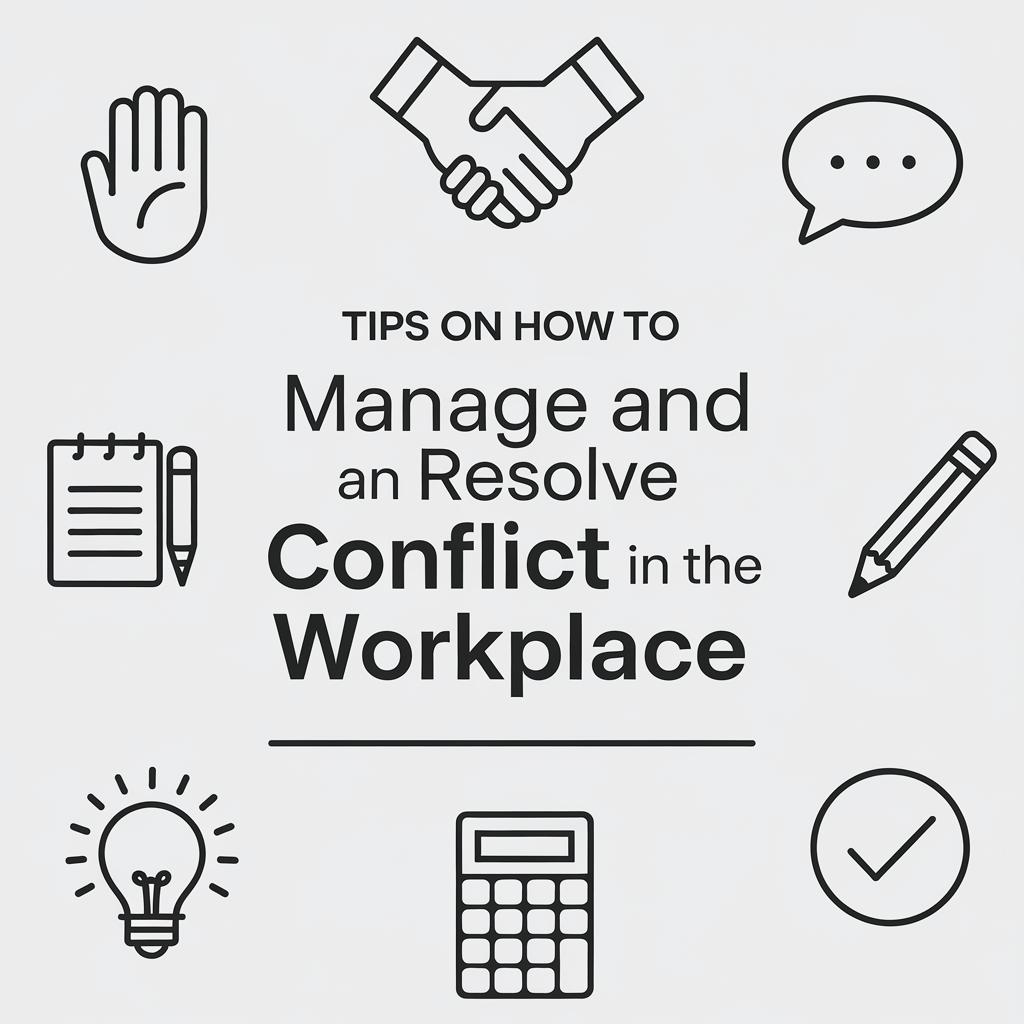7 Tips on How to Manage and Resolve Conflict in the Workplace
Effective conflict resolution in the workplace is essential for maintaining a productive and harmonious environment. Conflicts are inevitable when diverse minds collaborate, but the way they are handled can either drive innovation or hinder progress. In this blog post, we’ll explore the fundamental aspects of conflict resolution, delving into the Three C’s crucial for effective management. We’ll examine five essential conflict resolution skills to equip you with the tools necessary for navigating workplace challenges. Finally, we’ll guide you through seven proven steps to resolve conflicts successfully. By embracing these strategies, you can cultivate a more positive and cooperative work atmosphere.
What Is Conflict Resolution?
Conflict resolution is the process of facilitating a peaceful end to conflict and re-establishing a harmonious working environment. It involves understanding and addressing the source of discord, building bridges between differing perspectives, and fostering mutual respect among team members. Resolving conflicts effectively minimizes stress, boosts morale, and enhances productivity within the workplace.
In essence, conflict resolution aims to transform a potentially destructive situation into an opportunity for problem-solving and growth. By employing various strategies and techniques, individuals can learn to manage disagreements constructively and prevent them from escalating further. A well-handled conflict not only resolves immediate tensions but also strengthens workplace relationships in the long run.
The Three C’s of Conflict Resolution
The Three C’s of conflict resolution are Cooperation, Communication, and Compromise. These elements form the bedrock of effective conflict management. Cooperation involves fostering a spirit of teamwork where all parties are willing to work towards a common goal. By encouraging cooperative efforts, individuals can shift from adversarial mindsets to collaborative problem-solving.
Communication plays a pivotal role in conflict resolution. Open and honest dialogue enables parties involved to express their concerns, understand different perspectives, and identify underlying issues. Compromise, on the other hand, requires a willingness to make concessions and find mutually beneficial solutions. Together, these elements create a framework for facilitating successful conflict resolution.
5 Conflict Resolution Skills
1. Open Communication
Open communication is the cornerstone of conflict resolution, providing a platform for expressing thoughts and concerns openly. It involves transparent sharing of information and emotions, which helps prevent misunderstandings and builds trust among team members. By creating an environment where people feel comfortable voicing their opinions, you pave the way for effective conflict management.
Strong communication ensures that all parties are on the same page, reducing the chances of assumptions and misinformation exacerbating the conflict. Encouraging a culture of open dialogue and feedback can help individuals feel heard and valued, ultimately fostering a more harmonious workplace.
2. Active Listening
Active listening is the practice of fully concentrating, understanding, and responding to what others are saying. It involves giving undivided attention, acknowledging the speaker’s viewpoints, and providing feedback to demonstrate understanding. Active listening fosters empathy and respect, key ingredients in resolving conflicts amicably.
By approaching conversations with an active listening mindset, you can uncover underlying issues that contribute to the conflict, facilitating a deeper understanding and paving the way for effective resolution. This skill not only resolves current disputes but also enhances overall communication and strengthens relationships in the workplace.
3. Emotional Intelligence
Emotional intelligence involves recognizing, understanding, and managing one’s own emotions as well as those of others. In conflict situations, emotional intelligence allows individuals to remain calm, composed, and empathetic, helping de-escalate tensions and facilitate constructive dialogue.
By harnessing emotional intelligence, you can better navigate conflicts, tailor your approach to different personalities, and foster an atmosphere of respect and collaboration. Developing this skill enhances your ability to empathize with colleagues, leading to more effective conflict resolution and improved interpersonal relationships.
4. Impartiality
Impartiality is essential in conflict resolution, ensuring that issues are addressed fairly and objectively. It requires setting aside personal biases and judgments to focus solely on the facts and perspectives involved. By adopting an impartial stance, you create an environment of trust and credibility, enabling parties to feel comfortable expressing their concerns.
Impartiality fosters fairness and ensures that all parties are heard and understood without favoritism. This approach minimizes the risk of fueling further disagreements and reinforces confidence in the resolution process.
5. Patience
Patience is a vital skill in conflict resolution, allowing room for thoughtful consideration and measured responses. Conflicts are rarely resolved overnight, and achieving meaningful resolutions can take time. Demonstrating patience allows individuals to work through issues at their own pace, encouraging a sense of safety and openness.
By approaching conflicts with patience, you can create a supportive environment where parties feel understood and respected. Patience fosters an atmosphere of calm, facilitating more effective problem-solving and relationship-building in the workplace.
7 Proven Steps to Resolve a Conflict in the Workplace
1. Investigate the Situation
The first step in resolving workplace conflict is to investigate the situation thoroughly. Gather all relevant information, speak with involved parties, and consider the context to understand the root cause of the conflict. This information helps you to address the issue effectively and avoid making assumptions.
By conducting a thorough investigation, you gain a comprehensive understanding of the matter, which allows you to approach the conflict resolution process with clarity and objective insight.
2. Find Common Ground
Identifying common ground is crucial in conflict resolution, as it provides a foundation for collaboration. While parties may have opposing views, finding shared interests or goals can redirect focus toward mutual understanding and agreement.
Exploring commonalities fosters a sense of unity and cooperation, encouraging parties to work together toward a solution that satisfies everyone involved. Finding common ground is a powerful step toward transforming conflict into a collaborative problem-solving effort.
3. Brainstorm Potential Solutions
Once you’ve established common ground, engage all parties in brainstorming potential solutions. Encourage creativity and inclusivity during this process, allowing everyone to contribute their ideas freely. The goal is to generate a range of solutions that address the concerns of all parties.
This step not only uncovers viable strategies but also fosters a sense of ownership and empowerment, as everyone has a role in shaping the resolution. Collaborative brainstorming paves the way for effective and innovative conflict resolution.
4. Agree On A Solution
After brainstorming, evaluate the proposed solutions and reach a consensus on the most viable option. This step involves negotiating and considering the needs of all parties involved. It’s important to ensure that the chosen solution is practical, fair, and acceptable to everyone.
Agreeing on a solution sets the stage for effective implementation and ensures that all parties are committed to the resolution process. This consensus-building step solidifies trust and cooperation among team members.
5. Establish Responsibilities
Clearly defining responsibilities is vital for successful conflict resolution. Assign specific tasks and roles to each party involved in the solution, ensuring that everyone knows their responsibilities in the implementation phase.
Establishing responsibilities promotes accountability and clarity, minimizing confusion and facilitating a smooth resolution process. This step ensures that everyone is aligned and working collaboratively toward the same goal.
6. Document The Incident
Documenting the conflict and its resolution is an essential step to maintain transparency and accountability. This documentation serves as a reference for future situations and ensures that all parties have a clear record of the agreement reached.
A detailed record of the incident and resolution process helps to prevent similar conflicts and offers valuable insights for improving conflict management strategies in the future.
7. Follow Up
Following up after the resolution is important to ensure the solution is effective and all parties are satisfied with the outcome. This step involves periodic check-ins to address any lingering issues or concerns.
By following up, you demonstrate commitment to maintaining a harmonious work environment and fostering continuous improvement in conflict management. This step reinforces trust and reinforces the importance of collaborative problem-solving.
Lessons Learned
| Aspect | Details |
|---|---|
| Conflict Resolution Definition | Process of facilitating a peaceful end to conflict and re-establishing harmony. |
| The Three C’s | Cooperation, Communication, and Compromise. |
| Key Skills | Open Communication, Active Listening, Emotional Intelligence, Impartiality, Patience. |
| 7 Proven Steps | Investigate, Find Common Ground, Brainstorm Solutions, Agree, Establish Responsibilities, Document, Follow Up. |


